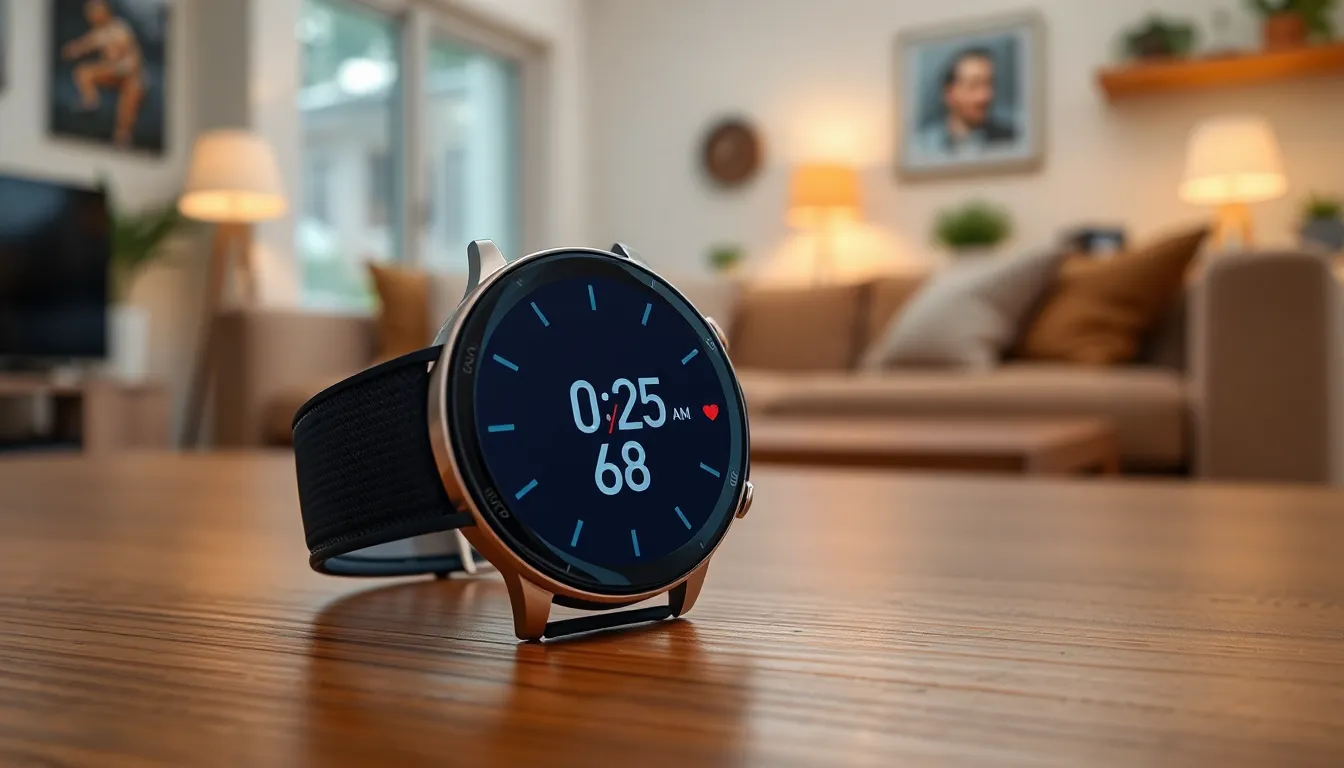Table of Contents
ToggleIn a world where multitasking is the name of the game, smartwatches have evolved from mere timekeepers to essential health companions. Imagine a device that not only tells you the time but also keeps an eye on your blood sugar levels. Talk about a wrist revolution! With the rise of smartwatches featuring blood sugar monitors, managing diabetes has never been easier—or cooler.
These high-tech gadgets offer more than just notifications and fitness tracking. They empower users to take control of their health with real-time data, all while sporting a sleek design that would make even James Bond jealous. So why settle for just telling the time when your watch can also help you stay on top of your health? Dive into the world of smartwatches that monitor blood sugar and discover how they can transform your daily routine into a health-conscious adventure.
Overview of Smart Watches with Blood Sugar Monitors
Smart watches equipped with blood sugar monitors offer vital support for individuals managing diabetes. These devices facilitate continuous glucose monitoring through advanced sensors, eliminating the need for frequent finger pricks. Users gain access to real-time data, which aids in making informed decisions about their diet and exercise.
Popular models integrate features like heart rate monitoring and activity tracking alongside blood sugar measurement. Many smart watches sync with mobile apps, allowing users to store and analyze their glucose levels over time. This feature empowers users to spot trends and adjust their management strategies accordingly.
Major brands consistently enhance their offerings in this market. Garmin, for instance, has introduced smart watches that combine fitness tracking with glucose monitoring, appealing to health-conscious consumers. Similarly, Apple includes blood sugar tracking capabilities in its latest device, catering to a broader audience.
Affordability varies significantly among smart watches with these capabilities. While some models sit at budget-friendly price points, others may be more expensive due to advanced technology and additional health features. It’s essential to consider personal health needs and budget when selecting a device.
Privacy concerns regarding health data arise with the adoption of smart watches. Manufacturers prioritize data security measures to protect users’ health information. Users often find comfort in brands that value transparency and comply with regulations.
Quality continues to improve as technology develops. Seamless integration into daily life makes these smart watches not just tools, but essential health companions. The growing popularity showcases their importance in managing health effectively.
Key Features to Consider

When choosing a smartwatch with a blood sugar monitor, several key features impact usability and effectiveness.
Accuracy and Reliability
Accuracy represents a critical factor in blood sugar monitoring. Users depend on precise readings to manage their health effectively. High-quality smartwatches incorporate advanced sensors that track glucose levels in real time. These sensors often undergo rigorous testing to ensure reliability. Consistent calibration enhances the accuracy of measurements, reducing discrepancies. Brands such as Apple and Garmin prioritize accuracy, providing trusted devices for managing diabetes. Choosing a smartwatch known for its reliability can significantly improve decision-making regarding diet and exercise.
User-Friendliness
User-friendliness plays a vital role when selecting a smartwatch. Intuitive interfaces simplify navigation, making them accessible for all age groups. Responsive touchscreens enhance the overall experience by enabling quick access to features. Customizable settings allow users to tailor alerts and notifications based on personal preferences. Compatibility with mobile apps improves data management, giving individuals better insights into their glucose levels. Well-designed user experiences foster engagement and encourage regular monitoring, which ultimately contributes to effective health management.
Battery Life
Battery life influences the overall functionality of a smartwatch. Devices with longer battery lives ensure continuous monitoring without frequent recharging. Typically, smartwatches with robust health features require more power, so users should seek models that balance functionality and endurance. Many advanced smartwatches boast battery lives of up to several days, providing peace of mind for users on the go. Charge time also matters; quicker charge capabilities allow for less downtime in monitoring capabilities. Effective battery performance enables uninterrupted use during daily activities, enhancing the smartwatch experience.
Top Smart Watches with Blood Sugar Monitoring
Smartwatches with blood sugar monitoring capabilities play a crucial role in health management for users, particularly those managing diabetes. These devices offer varying features and specifications, catering to different preferences and needs.
Product Reviews
Apple Watch Series 8 integrates advanced sensors that provide accurate blood sugar readings along with heart rate tracking. It displays real-time glucose data on the screen, allowing users to make quick dietary decisions. Garmin Venu 2 also features a glucose monitoring capability, known for its user-friendly interface and long battery life. Fitbit Sense combines stress management and blood sugar monitoring, enabling a comprehensive health overview. Samsung Galaxy Watch 5 stands out with its sleek design and ability to sync data seamlessly with fitness apps, enhancing user experience.
Comparison Table
| Smartwatch | Blood Sugar Monitoring | Battery Life | User Interface | Additional Features |
|---|---|---|---|---|
| Apple Watch Series 8 | Yes | 18 hours | Intuitive | Heart rate monitoring, ECG |
| Garmin Venu 2 | Yes | 11 days | User-friendly | Activity tracking, GPS |
| Fitbit Sense | Yes | 6 days | Customizable | Stress management, skin temperature |
| Samsung Galaxy Watch 5 | Yes | 40 hours | Seamless sync | Fitness tracking, accurate GPS |
Benefits of Using a Smart Watch with Blood Sugar Monitor
Smartwatches with blood sugar monitors provide numerous advantages for users managing their health. They streamline health tracking and enhance lifestyle choices with real-time data.
Health Monitoring
Continuous health monitoring plays a crucial role in managing blood sugar levels for individuals with diabetes. Smartwatches constantly track glucose levels, providing immediate alerts for critical changes. Users can adjust food intake and activity levels based on real-time feedback. Advanced sensors deliver accurate readings, reducing the need for frequent finger pricks. They simplify the process of health management by combining multiple metrics, such as heart rate and activity levels, in one device. Many models also offer features to log dietary choices, helping users make informed decisions.
Convenience and Accessibility
Convenience significantly improves the experience of managing diabetes with smartwatches. Users access key health metrics directly from their wrists, making information readily available. Many devices sync seamlessly with smartphone apps, allowing users to analyze their data over time. Quick access to data promotes proactive management of health conditions. Customizable notifications facilitate timely responses to abnormal glucose levels, empowering users to take action. Overall, smartwatches enhance the user experience by merging functionality with style, ensuring health management remains accessible and efficient.
Challenges and Limitations
Smartwatches with blood sugar monitors face several challenges that can affect their effectiveness. Accuracy remains a top concern; discrepancies in readings can lead to inappropriate dietary or lifestyle choices. Many devices rely on advanced sensors, yet variations in individual physiology may influence their performance, resulting in inconsistent glucose measurements.
Battery life presents another limitation. While some models boast impressive longevity, frequent monitoring can drain battery reserves quickly. Users may find themselves needing to recharge their devices more often than anticipated, potentially disrupting continuous glucose tracking.
The user interface also plays a significant role in overall satisfaction. A complex or unintuitive interface can lead to confusion and frustration, diminishing the user experience. Simplified navigation and clear visual displays are critical for individuals who need to access their data quickly and efficiently.
Privacy concerns surrounding health data persist as another challenge. As these devices collect sensitive information, manufacturers must prioritize robust security measures to protect users’ personal data from breaches. Transparency about data handling practices is essential to build trust among users.
Additionally, maintaining compliance with health regulations can complicate the development of these devices. Meeting the strict guidelines set by regulatory bodies often requires extensive research and testing, influencing the speed at which new features and improvements reach the market.
Investing in smartwatches with blood sugar monitors should involve considering these limitations. Users must evaluate their specific needs against performance capabilities, ensuring the device aligns with their health management goals.
Smartwatches with blood sugar monitors represent a significant advancement in personal health management. They empower users to take control of their diabetes by offering real-time glucose data and seamless integration with fitness tracking. With features like customizable notifications and user-friendly interfaces, these devices make health monitoring more accessible and efficient.
While challenges such as accuracy and battery life exist, the benefits often outweigh the drawbacks. As technology continues to evolve, these smartwatches are becoming indispensable tools for health-conscious individuals. By choosing a model that fits personal needs and preferences, users can enhance their lifestyle while effectively managing their health. Embracing this technology can lead to a more informed and proactive approach to wellness.











